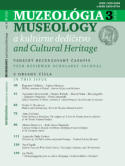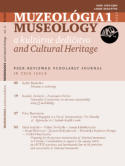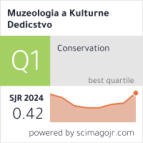

MUZEOLÓGIA
MUSEOLOGY
a kultúrne dedičstvo
and Cultural Heritage

News
Journal Muzeológia a
kultúrne dedičstvo -
Museology and Cultural
Heritage:
SJR 2024: 0,424 (Q1)
Museology SJR rank: 8/83 (Q1) Conservation SJR rank: 11/103 (Q1)JIF WoS 2023: 0,6
JCI WoS 2023: 1,28, Q1 ESCI: 49/411 (Q1)New issue
Muzeológia a kultúrne
dedičstvo 1/2025
online New volume Studia Museologica Slovaca, vol. 8 (2024) online New volume Populačné štúdie Slovenska 17 (2024) onlineNew book
P. Tišliar (ed.). Osobnosti uměleckoprůmyslového muzejnictví (2025). online
Contents 1/2023
Title: Museum as technology
Abstract: There are no complex studies in the field of cultural theory on the effectiveness of the museum. It is not clear what are the
main versions of the sociocultural purpose of the museum. It has not been revealed which sociocultural applications of the museum
are harmful to the institution and society as a whole, and which are not. The meta-problem of research is caused by the fact that the
empirical question of choosing the best strategy for the functioning of the museum has not been brought to the theoretical level. There
are only particular scientific discourses that have not passed the procedure of scientific criticism and logical-deductive testing. Thus,
the scientific problem of the sociocultural purpose of the museum in view of its institutional specifics can be solved by formulating
scientific theories that correspond to the particular directions of empirical use of the museum.
Author: Rudenko Serhii
Publication order reference: Kyiv National University of Culture and Arts, Department of Museum Management, Ukraine, e-mail:
rudenkosb@ukr.net , https://orcid.org/0000-0002-2319-1845
Source: Muzeológia a kultúrne dedičstvo, year: 2023, vol.: 11, number: 1, pages: 5-17.
Key words: museum as a sociocultural institution, the sociocultural purpose of the museum, the institutional specifics of the museum,
curatorship, culturological museum, sociocultural technology
Language: English
online full-text PDF
DOI: 10.46284/mkd.2023.11.1.1
Title: Generation Z perspectives on museum sustainability using Q methodology
Abstract: Museums and researchers require knowledge of how museums think about and practice sustainability to understand how
sustainability considerations can further be incorporated and institutionalised into museum practice on four pillars: environmental,
social, economic and cultural. A systematic literature review was carried out to explore the theoretical background of sustainable
museums. This study, which used Q methodology, was designed to determine museum visitors’ preferences related to the most
important sustainability elements of museums. The participants in the study were 24 museum visitors from Generation Z in Hungary.
Data were collected through 37 Q statements. According to the findings of the research, young museum visitors can be distinguished
into three groups (factors): Conscious, Experience-seeking, and Enthusiastic-to-learn visitors.
Authors: Ásványi Katalin, Fehér Zsuzsanna
Publication order reference: Department of Sustainable Development and Environmental Economics Corvinus University of
Budapest, 8 Fővám Square, 1093 Budapest, Hungary, e-mail: katalin.asvanyi@uni-corvinus.hu https://orcid.org/0000-0002-1594-
8879; Ludwig Museum, 1 Komora Marcell Street, 1095 Budapest, Hungary & Tourism Department, Corvinus University of Budapest, 8
Fővám Square, 1093 Budapest, Hungary, e-mail: feher.zsuzsanna@ludwigmuseum.hu, https://orcid.org/0000-0002-7700-2966
Source: Muzeológia a kultúrne dedičstvo, year: 2023, vol.: 11, number: 1, pages: 19-35.
Keywords: sustainable museum, Q methodology, Generation Z
Language: English
online full-text PDF
DOI: 10.46284/mkd.2023.11.1.2
Title: From Biography to a Net of Interpretations: The Plurality of Approaches to Vladimír Karfík’s
work
Abstract: The aim of this study is to justify a partial shift from the biographical approach in the author’s ongoing research into the work
of architect Vladimír Karfík’s, especially if that research is directed towards raising present-day appreciation of his output. The
inspiration comes from pragmatic aesthetics, as understood by philosopher Richard Shusterman, which considers the possibility of
appreciating a work of art and architecture without the premise of one universal truth. The “net of interpretations” metaphor suggests
that different interpretative lines can be perceived as equivalent in all their diversity, and there is no single “true” image of the work that
lies underneath. The proposition of the study is argued both on a theoretical level and through the analysis of existing publications
devoted to Karfík’s work and personality.
Author: Bartošová Nina
Publication order reference: Slovak University of Technology in Bratislava, Faculty of Architecture and Design, Institute of History
and Theory of Architecture and Monument Restoration, Námestie slobody 19, 812 45 Bratislava, Slovakia, e-mail:
nina.bartosova@stuba.sk, https://orcid.org/0000-0003-1903-1045
Source: Muzeológia a kultúrne dedičstvo, year: 2023, vol.: 11, number: 1, pages: 37-51.
Keywords: interpretation, Vladimír Karfík, biography, cultural turn, architectural historical research
Language: English
online full-text PDF
DOI: 10.46284/mkd.2023.11.1.3
Title: Preparing for the post-war reconstruction of historical monuments in Ukraine: Considerations
in regard of the ongoing Polish post-WWII experience and international law on the protection and
conservation of historical monuments
Abstract: The article deals with three groups of issues, which are closely interrelated. The main problem discussed is the issue of the
reconstruction, revalorisation and protection of Ukrainian monuments exposed to destruction as a result of warfare and Russia’s
invasion of Ukraine. The second issue presented is the experience of Polish conservators in the area of cities destroyed during World
War II. The third issue is international legislation in the field of heritage protection, which was analysed for the planned activities in the
area of reconstruction and revaluation of Ukrainian monuments after the end of the war. The above-mentioned research was carried
out by a Polish-Ukrainian team of heritage conservators, which seeks to be involved in the process of saving Ukrainian cultural
heritage.
Authors: : Ivashko Yulia, Tovbych Valerii, Hlushchenko Artem, Belinskyi Sergii, Kobylarczyk Justyna, Kuśnierz-Krupa
Dominika, Dmytrenko Andrii
Publication order reference: Kyiv National University of Construction and Architecture, Ukraine, e-mail: yulia-ivashko@ukr.net,
https://orcid.org/0000-0003-4525-9182; Kyiv National University of Construction and Architecture, Ukraine, e-mail:
tovbych@gmail.com, https://orcid.org/0000-0002-4794-4944; Head of the Department of Urban Planning and Architecture of the
Chernihiv Regional State Administration, Ukraine, e-mail: gluschenko.art@gmail.com, https://orcid.org/0000-0001-6186-0387; Knights
of the Winter Campaign, 28th separate mechanised brigade, Ukraine, e-mail: serhii_belinskyi@meta.ua, https://orcid.org/0000-0003-
2359-2507; Cracow University of Technology, Faculty of Architecture, Poland, e-mail: justyna.kobylarczyk@pk.edu.pl,
https://orcid.org/0000-0002-3358-3762; Cracow University of Technology, Faculty of Architecture, Poland, e-mail: dkusnierz-
krupa@pk.edu.pl, https://orcid.org/0000-0003-1678-4746; National University “Yuri Kondratyuk Poltava Polytechnic”, e-mail:
metr5555@ukr.net, https://orcid.org/0000-0003-4757-5218
Source: Muzeológia a kultúrne dedičstvo, year: 2023, vol.: 11, number: 1, pages: 53-71.
Keywords: problems of destruction, experience of restoration, legislative bases, preservation, consequences of war, Ukraine
Language: English
online full-text PDF
DOI: 10.46284/mkd.2023.11.1.4
Articles (Abstracts)

Full-text version
DOI:10.46284/mkd.2023.11.1.0
ISSN 1339-2204
eISSN 2453-9759
EV 1/22/EPP
Vol. 11 (2023), No. Is. 1



























